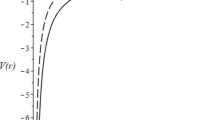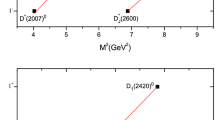Abstract
In this work, we present the charmed meson semileptonic decays in the covariant confined quark model. The necessary transition form factors for the channels \(D \rightarrow (K, \pi )\) are computed in the whole physical range of momentum transfer. These form factors are then utilized for computation of semileptonic branching fractions. We also compare our results with the recent BESIII data and CLEO data.
Access provided by Autonomous University of Puebla. Download conference paper PDF
Similar content being viewed by others
Keywords
13.1 Introduction
Semileptonic decays of charmed meson provide the key window to understand the decay of heavy quark dynamics because of the involvement of strong as well as weak interaction. The CKM matrix elements \(|V_{cd}|\) and \(|V_{cs}|\) can be extracted from semileptonic decays of \(D_{(s)}\) mesons as they are parameterized by the form factor calculations. Experimentally, the data on form factors and branching fractions are reported by BESIII [1,2,3,4], BABAR [5], Belle [6], and CLEO collaborations [7]. The form factors for the channels \(D \rightarrow (K, \pi )\) have also been reported using lattice quantum charmodynamics (LQCD) by ETM Collaborations [8, 9] and light cone sum rules (LCSR) [10]. The form factors and branching fractions are also computed using light front quark model [11], heavy meson chiral theory [12], constituent quark model [13], and chiral unitary approach [14]. The charmed meson decay properties are also studied in the potential model formalism [15,16,17,18].
In this article, we employ the Covariant Confined Quark Model for computation of semileptonic transition form factors and branching fractions of D mesons. We compare our findings with the experimental data from the BESIII, BABAR, CLEO, and Belle collaborations.
13.2 Form Factors and Branching Fractions in Covariant Confined Quark Model
The Covariant Confined Quark Model (CCQM), developed by Efimov and Ivanov [19,20,21,22] is a quantum field theoretical approach for hadronic interaction with the constituent quark via exchange of quark only. The effective interaction Lagrangian for meson \(M(q_1,\bar{q}_2)\) corresponding to the constituent quarks \(q_1\) and \(\bar{q}_2\) is given by
with \(F_M(x;x_1,x_2)\) as the vertex function that characterizes the quark distribution within the mesons. For simplicity, we choose the vertex function to be of the Gaussian form. Here, \(\varGamma _M\) is the Dirac matrix corresponding to spin of the respective mesonic field M(x) and \(g_M\) is the meson coupling constant computed from the meson self-energy diagram. The model parameters, namely quark masses and size parameters are given in Tab. 13.1.
For computation of semileptonic branching fractions, the invariant matrix element can be written as
where \(G_F\) is the Fermi coupling constant, P, V correspond to the pseudoscalar or vector mesons in the final state, respectively. The matrix element for the semileptonic decays can be written in terms of transition form factors as
where \(P = p_1 + p_2\), \(q = p_1-p_2\) and \(p_1\), \(p_2\) are the momenta of parent and daughter mesons, respectively. We present our form factors in Fig. 13.1. The form factors in the double pole approximation are given as
The form factors and associated double pole parameters are given in Table 13.2.
After defining the form factors, we compute the semileptonic branching fractions using the relations [23, 24]
Here \(|\mathbf{p_2}| =\lambda ^2 (m_D^2, m_{P/V}^2, q^2)/2 m_D^2\) is the momentum of daughter meson in the rest frame of the D meson with \(\lambda \) is the Källen function. \(H_\pm \), \(H_0\), and \(H_t\) are the helicity amplitudes expressed as
For \(D \rightarrow P\) channel:
For \(D \rightarrow V\) channel:
The computed semileptonic branching fractions for \(D^+\) meson are given in Table 13.3 in comparison with experimental observations.
13.3 Results and Discussion
Having defined the model parameters and form factors, we compute the semileptonic branching fractions within the framework of the Covariant Confined Quark Model. The numerical results of semileptonic branching fractions are tabulated in Table 13.3. Our results for \(D^+ \rightarrow \pi ^0 e^+ \nu _e\) are found to be nearer to the BESIII data and for muon channel the experimental results are still not available. For \(D^+ \rightarrow \bar{K}^0 \ell ^+ \nu _\ell \) channel, our results are in good agreement with the CLEO and BESIII data. For \(D^+ \rightarrow \bar{K}^*(892)^0 \ell ^+ \nu _\ell \) channel our results overestimate the experimental data. For detailed description of the model and computation technique we suggest the readers to refer our papers [25,26,27] as well as our recent review article [28]. In these papers, we have extensively studied the leptonic and semileptonic decay of D and \(D_s\) mesons. We study \(D^{+(0)} \rightarrow (K, K^*(892), \pi , \rho , \omega , \eta , \eta ^\prime , D^0) \ell ^+ \nu _\ell \), \(D_s^+ \rightarrow (K, K^*(892)^0, \phi , \eta , \eta ^\prime , D^0) \ell ^+ \nu _\ell \). We also study the other physical observables such as forward-backward asymmetry, longitudinal and transverse polarizations, lepton-side, and hadron-side convexity parameters.
The study of hadronic properties in Covariant Confined Quark Model is very general and this formalism is applicable to any number of quarks with any number of loops. In the last few years this formalism is successfully employed for computation of decay properties of \(B_{(s)}\) mesons [32,33,34,35,36,37,38], \(B_{c}\) mesons [39,40,41], charmed and beauty baryons [42,43,44,45,46] and exotic states [47,48,49].
References
M. Ablikim et al., BESIII collaboration. Phys. Rev. Lett. 122, 011804 (2019)
M. Ablikim et al., BESIII collaboration. Phys. Rev. Lett. 121, 171803 (2018)
M. Ablikim et al., BESIII collaboration. Phys. Rev. D 96, 012002 (2017)
M. Ablikim et al., BESIII collaboration. Phys. Rev. D 92, 072012 (2015)
J.P. Lees et al., BABAR collaboration. Phys. Rev. D 91, 052022 (2015)
L. Widhalm et al., Belle collaboration. Phys. Rev. Lett. 97, 061804 (2006)
D. Besson et al., CLEO collaboration. Phys. Rev. D 80, 032005 (2009)
V. Lubicz et al., ETM collaboration. Phys. Rev. D 96, 054514 (2017)
V. Lubicz et al., ETM collaboration. Phys. Rev. D 98, 014516 (2018)
Y.L. Wu, M. Zhong, Y.B. Zuo, Int. J. Mod. Phys. A 21, 6125 (2006)
H.-Y. Cheng, X.-W. Kang, Eur. Phys. J. C 77, 587 (2017)
S. Fajfer, J.F. Kamenik, Phys. Rev. D 72, 034029 (2005)
D. Melikhov, B. Stech, Phys. Rev. D 62, 014006 (2000)
T. Sekihara, E. Oset, Phys. Rev. D 92, 054038 (2015)
V. Kher, N. Devlani, A.K. Rai, Chin. Phys. C 41, 073101 (2017)
N. Devlani, A.K. Rai, Int. J. Theor. Phys. 52, 2196 (2013)
N. Devlani, A.K. Rai, Eur. Phys. J. A 48, 104 (2012)
N. Devlani, A.K. Rai, Phys. Rev. D 84, 074030 (2011)
G.V. Efimov, M.A. Ivanov, Int. J. Mod. Phys. A 4, 2031 (1989)
G.V. Efimov, M.A. Ivanov, The Quark Confinement Model of Hadrons (IOP, Bristol, 1993)
A. Faessler, T. Gutsche, M.A. Ivanov, J.G. Körner, V.E. Lyubovitskij, Eur. Phys. J. Direct C 4, 1 (2002)
T. Branz, A. Faessler, T. Gutsche, M.A. Ivanov, J.G. Körner, V.E. Lyubovitskij, Phys. Rev. D 81, 034010 (2010)
M.A. Ivanov, J.G. Körner, C.T. Tran, Phys. Rev. D 92, 114022 (2015)
T. Gutsche, M.A. Ivanov, J.G. Körner, V.E. Lyubovitskij, P. Santorelli, N. Habyl, Phys. Rev. D 91, 074001 (2015) [Erratum: Phys. Rev. D 91, 119907 (2015)]
N.R. Soni, J.N. Pandya, Phys. Rev. D 96, 016017 (2017) [Erratum: Phys. Rev. D 99, 059901 (2019)]
N.R. Soni, M.A. Ivanov, J.G. Körner, J.N. Pandya, P. Santroelli, C.T. Tran, Phys. Rev. D 98, 114031 (2018)
N.R. Soni, J.N. Pandya, EPJ Web Conf. 202, 06010 (2019)
M.A. Ivanov, J.G. Korner, J.N. Pandya, P. Santroelli, N.R. Soni, J.N. Pandya, Front. Phys. 14, 64401 (2019)
M. Ablikim et al., BESIII collaboration. Eur. Phys. J C 76, 369 (2016)
M. Tanabashi et al., Particle data group. Phys. Rev. D 98, 030001 (2018)
R.A. Briere et al., CLEO collaboration. Phys. Rev D 81, 112001 (2010)
S. Dubnicka, A.Z. Dubnickova, M.A. Ivanov, A. Liptaj, P. Santorelli, C.T. Tran, Phys. Rev. D 99, 014042 (2019)
M.A. Ivanov, J.G. Körner, C.T. Tran, Phys. Part. Nucl. Lett. 14, 669 (2017)
M.A. Ivanov, J.G. Körner, C.T. Tran, Phys. Rev. D 95, 036021 (2017)
M.A. Ivanov, J.G. Körner, C.T. Tran, Phys. Rev. D 94, 094028 (2016)
S. Dubniccka, A.Z. Dubnickova, A. Issadykov, M.A. Ivanov, A. Liptaj, S.K. Sakhiyev, Phys. Rev. D 93, 094022 (2016)
A. Issadykov, M.A. Ivanov, S.K. Sakhiyev, Phys. Rev. D 91, 074007 (2015)
M.A. Ivanov, J.G. Körner, S.G. Kovalenko, P. Santorelli, G.G. Saidullaeva. Phys. Rev. D 85, 034004 (2012)
A. Issadykov, M.A. Ivanov, Phys. Lett. B 783, 178 (2018)
C.T. Tran, M.A. Ivanov, J.G. Körner, P. Santorelli, Phys. Rev. D 97, 054014 (2018)
S. Dubnicka, A.Z. Dubnickova, A. Issadykov, M.A. Ivanov, A. Liptaj, Phys. Rev. D 96, 076017 (2017)
T. Gutsche, M.A. Ivanov, J.G. Körner, V.E. Lyubovitskij, arXiv:1905.06219
T. Gutsche, M.A. Ivanov, J.G. Körner, V.E. Lyubovitskij, Z. Tyulemissov, Phys. Rev. D 99, 056013 (2019)
T. Gutsche, M.A. Ivanov, J.G. Körner, V.E. Lyubovitskij, P. Santorelli, C.T. Tran, Phys. Rev. D 98, 053003 (2018)
T. Gutsche, M.A. Ivanov, J.G. Körner, V.E. Lyubovitskij, Phys. Rev. D 98, 074011 (2018)
T. Gutsche, M.A. Ivanov, J.G. Körner, V.E. Lyubovitskij, Phys. Rev. D 96, 054013 (2017)
F. Goerke, T. Gutsche, M.A. Ivanov, J.G. Körner, V.E. Lyubovitskij, Phys. Rev. D 96, 054028 (2017)
F. Goerke, T. Gutsche, M.A. Ivanov, J.G. Körner, V.E. Lyubovitskij, P. Santorelli, Phys. Rev. D 94, 094017 (2016)
T. Gutsche, M.A. Ivanov, J.G. Körner, V.E. Lyubovitskij, K. Xu, Phys. Rev. D 96, 114004 (2017)
Acknowledgments
We thank our collaborators Prof. M. A. Ivanov, Prof. J. G. Körner, Prof. P. Santorelli and Dr. C. T. Tran for their support. J. N. P. acknowledges the financial support from the University Grants Commission of India under Major Research Project F.No.42-775/2013(SR).
Author information
Authors and Affiliations
Corresponding author
Editor information
Editors and Affiliations
Rights and permissions
Copyright information
© 2021 Springer Nature Singapore Pte Ltd.
About this paper
Cite this paper
Soni, N.R., Pandya, J.N. (2021). Semileptonic Decays of Charmed Meson. In: Behera, P.K., Bhatnagar, V., Shukla, P., Sinha, R. (eds) XXIII DAE High Energy Physics Symposium. DAEBRNS HEPS 2018 2018. Springer Proceedings in Physics, vol 261. Springer, Singapore. https://doi.org/10.1007/978-981-33-4408-2_13
Download citation
DOI: https://doi.org/10.1007/978-981-33-4408-2_13
Published:
Publisher Name: Springer, Singapore
Print ISBN: 978-981-33-4407-5
Online ISBN: 978-981-33-4408-2
eBook Packages: Physics and AstronomyPhysics and Astronomy (R0)





